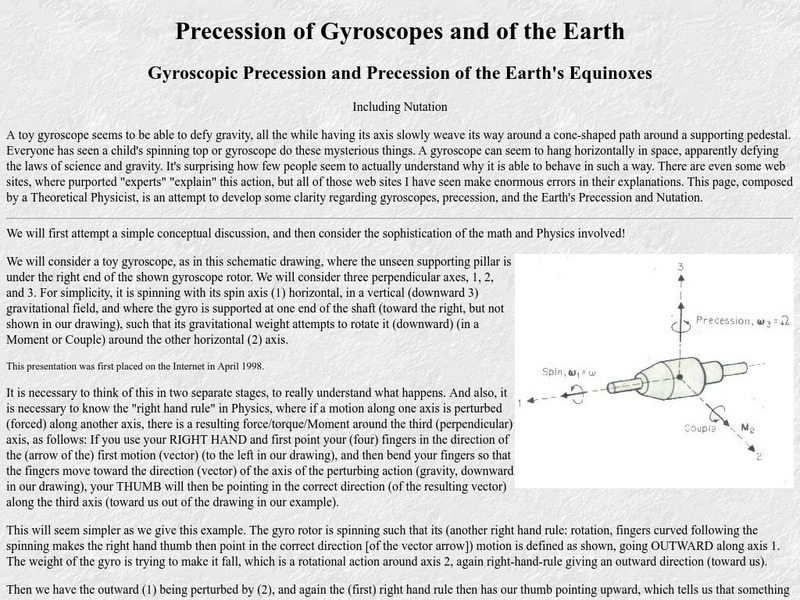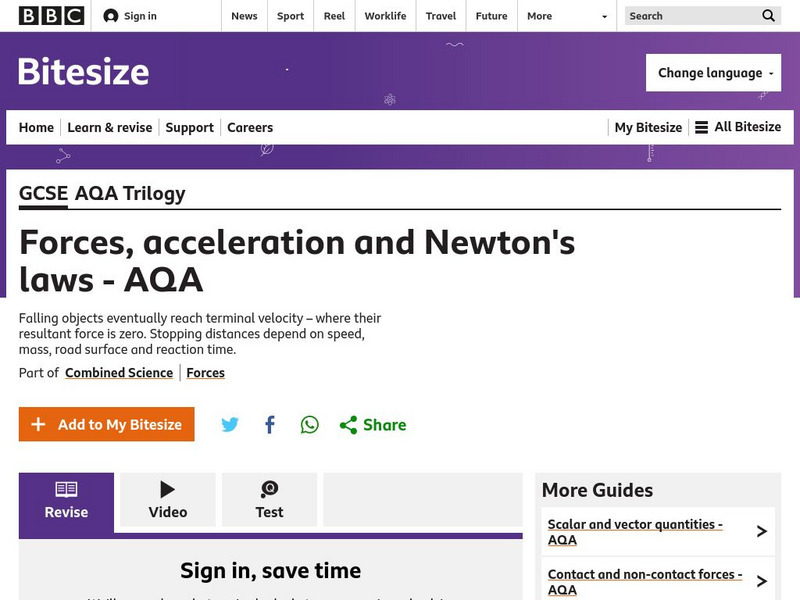Exploratorium
Exploratorium: Science Snacks: Downhill Race
An activity that explores how two cylinders that are identical in shape and mass may travel down a hill differently due to how their mass is distributed. Learn how the distribution of mass in an object can affect its translational...
Museum of Science
Museum of Science and Industry Chicago: Online Science: Drop Eggs Into Cups
Step-by-step illustrated instructions showing how to drop four eggs into four cups without touching them. Demonstrates the concept of inertia according to Newton's first law of motion.
TeachEngineering
Teach Engineering: Motion Commotion
Students learn why and how motion occurs and what governs changes in motion, as described by Newton's three laws of motion. They gain hands-on experience with the concepts of forces, changes in motion, and action and reaction. In an...
Other
Precession of a Gyroscope and of the Earth's Axis
Describes and calculates the precession of a gyroscope and also discusses the precession of the Earth's axis. Includes several pictures, diagrams, formulas, and details.
CK-12 Foundation
Ck 12: Physical Science: Inertia
[Free Registration/Login may be required to access all resource tools.] Explains inertia and how it affects motion, the relationship between inertia and mass, and how to overcome inertia.
Sophia Learning
Sophia: Introduction to Mass
A narrated screencast explains the mass of an object as it relates to inertia. [3:01]
Physics Classroom
The Physics Classroom: Satellite Motion
An animation depicting the path of projectiles launched at various launch speeds from the fictional Newton's Mountain. Accompanying text discusses satellite motion and the requirements of orbital motion. Links to further information is...
Annenberg Foundation
Annenberg Learner: Amusement Park Physics: Roller Coaster
This interesting and interactive exhibit demonstrates how Newton's Laws of Motion impact the design and safety of roller coasters.
Physics Classroom
The Physics Classroom: Energy Transport and the Amplitude of a Wave
The energy transport phenomenon and amplitude are explored in this lesson. Questions are found at the end of the lesson to check understanding of the concepts presented.
Science Bob Pflugfelder
Science Bob: The Lincoln High Dive
Instructions for a science demonstration of Newton's first law of motion using common supplies. Learn how to turn the demonstration into an experiment.
Exploratorium
Exploratorium: Science Snacks: Whack a Stack
Investigate Newton's first law of motion using just a set of wood blocks.
Bill Nye
Bill Nye: Pages of Inertia
This tutorial from Bill Nye demonstrates the power of inertia by using a dictionary to soften a blow.
Physics Classroom
The Physics Classroom: Inertia and Mass
This is part of a lesson on Newton's Laws of Motion that focuses on inertia and mass. It restates Newton's first law of motion. The lesson also gives a helpful visual description concerning friction.
Physics Classroom
The Physics Classroom: Newton's Laws: Newton's First Law
In this illustrated introduction of Newton's Laws of Motion, the ways in which motion can be explained will be discussed.
Physics Classroom
The Physics Classroom: Newton's Laws: Inertia and Mass
Through illustrated examples and interactive practice problems, students explore the relationship of inertia and mass.
Physics Classroom
The Physics Classroom: Circular and Satellite Motion: Centripetal Force
Through illustrated examples and practice problems, students explore the centripetal force requirement. So for an object moving in a circle, there must be an inward force acting upon it in order to cause its inward acceleration.
Physics Classroom
The Physics Classroom: Newton's Laws: Newton's Law of Inertia the Motorcyclist
Without a seat belt, the rider of a motorcycle is more likely to maintain its state of motion after running into an obstacle. The animation here depicts this scenario.
Physics Classroom
The Physics Classroom: Newton's Laws: Law of Inertia the Truck and Ladder
Students learn the basics of the law of inertia with this short tutorial and accompanying animation which demonstrates the motion.
Physics Aviary
Physics Aviary: Moment of Inertia of Pulley
This lab is designed to have students learn how the size, mass and mass distribution of a pulley influences the rate at which a mass attached to the pulley will accelerate. The pulley is frictionless and the string's mass is negligible.
Physics Aviary
Physics Aviary: Disk Rolling Down Incline
This lab to look at how the moment of inertia affects the motion of a wheel down an incline.
BBC
Bbc: Gcse Bitesize: Forces, Acceleration and Newton's Laws Aqa
This lesson focuses on Newton's First Law: an object remains in the same state of motion unless a resultant force acts on it. If the resultant force on an object is zero, this means: a stationary object stays stationary; a moving object...
Texas Education Agency
Texas Gateway: Glossary for Forces and Newton's Laws
This is a glossary of terms and definitions used in Chapter 4: Force and Newton's Laws of Motion from the AP Physics online text.
Texas Education Agency
Texas Gateway: 4.2 Newton's First Law of Motion: Inertia
By the end of this section, you will be able to define mass and inertia and to understand Newton's First Law of Motion: There exists an inertial frame of reference such that a body at rest remains at rest, or, if in motion, remains in...
CK-12 Foundation
Ck 12: Plix Series: Newton's First and Second Laws
[Free Registration/Login Required] Read a force scenario, and then analyze the graphs provided to gain an understanding of inertia and force. After the activity, answer three challenge questions to check for understanding.











